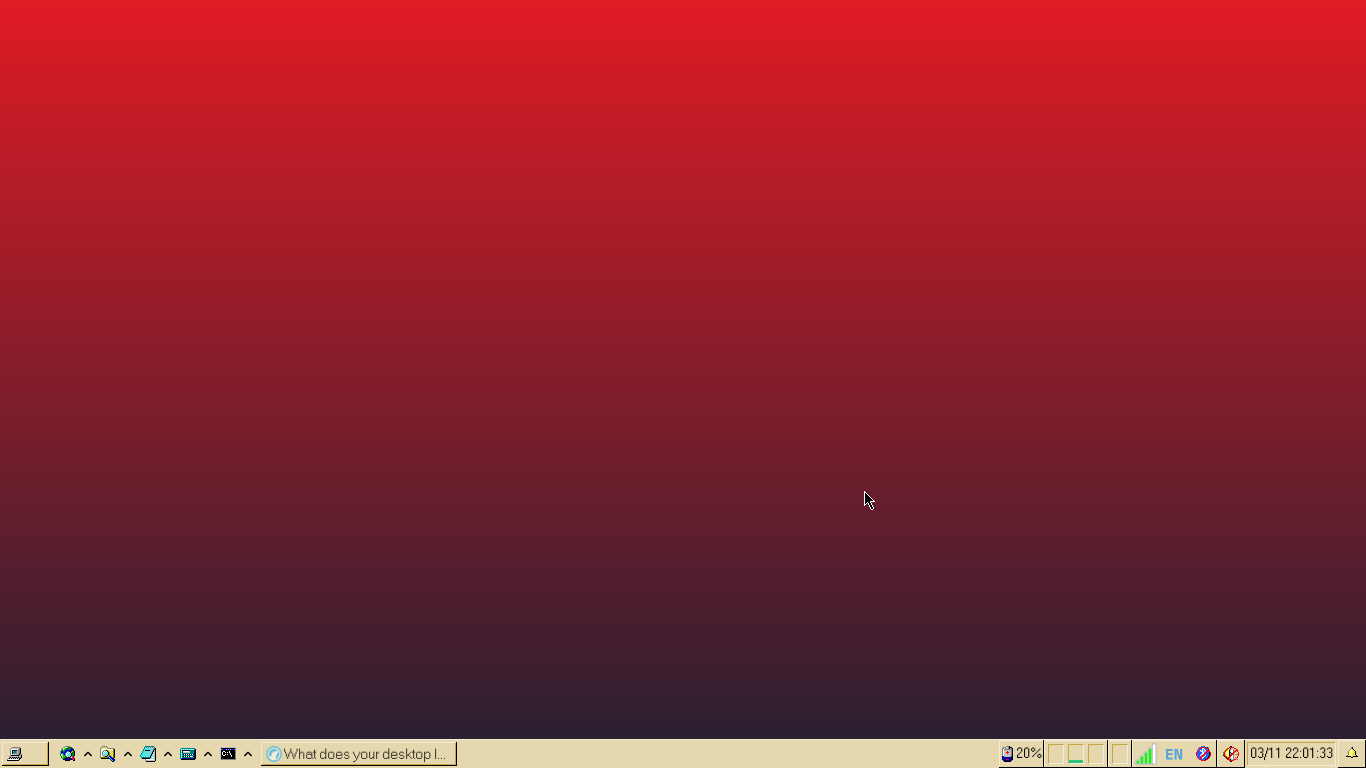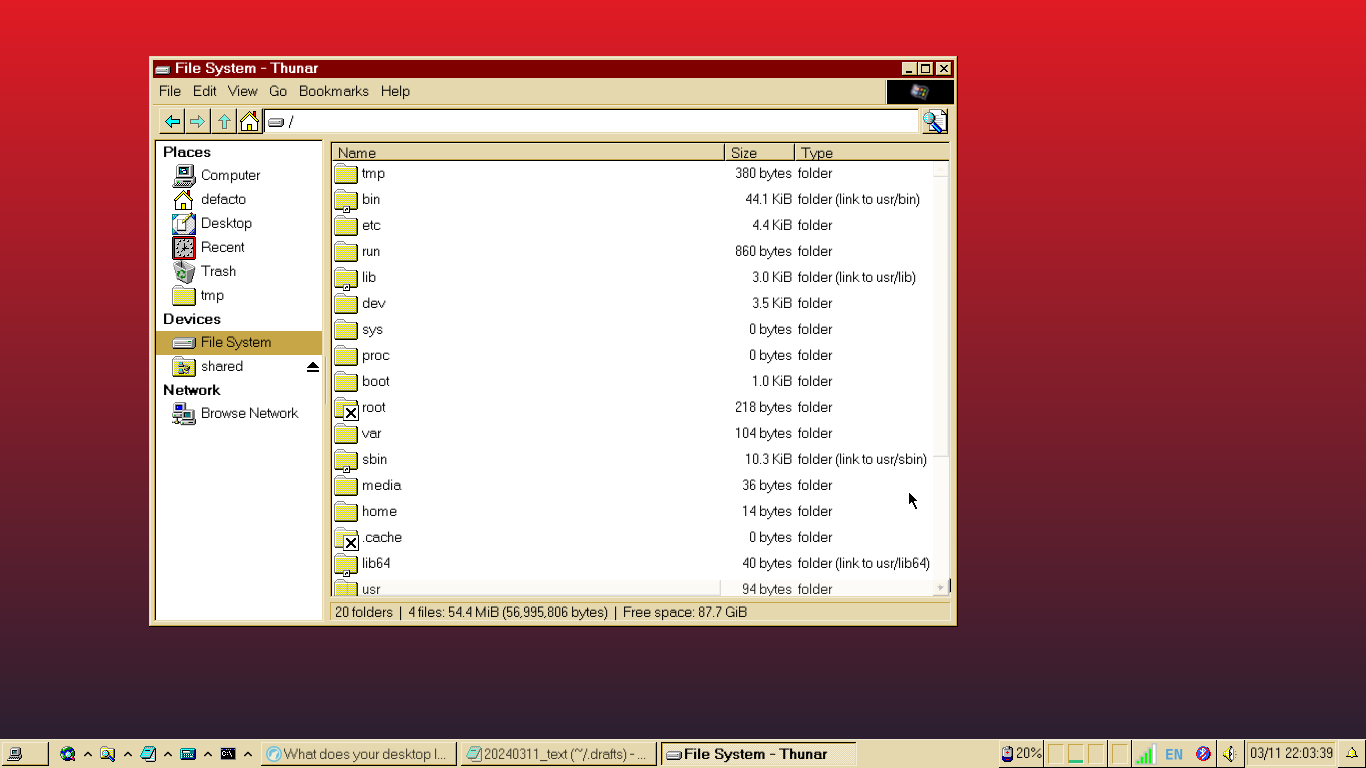monovergent 🏁
- 3 Posts
- 11 Comments
XFCE4. It’s intuitive and predictable without sacrificing the ability to customize it exactly the way I want (with Chicago95 ofc). The built-in panel widgets are nothing short of amazing: battery, CPU, RAM, network, and disk monitors with labels toggled off to save space and a clock with only what I need on one line:
MM/DD HH:mm:ssEnough features so that it “just works” (no nitpicking through config files), especially on laptops, without being bloated in any way. Bonus of its lightweight nature is that I can keep my Debian/XFCE setup consistent across all of my machines, both old and new.
Can’t wait for the finished xfwm4 port to wayland so I don’t have to sacrifice some security running X11 and so I can do fractional scaling on hidpi machines.
What did it in were the semi-annual mandatory feature updates, which restored the invasive settings and bloat I worked hard to remove. Already being acquainted with Linux at that point, I began dual-booting and later having Windows on an entirely separate machine for a few stubborn programs I needed for work.
What made me acquainted with Linux was looking for alternatives after the loss of theming options and the start menu in Windows 8. That eventually brought me to my present Debian setup with the Chicago 95 theme, which recreates (and even improved) the workflow and stability I had grown to love in Windows 2000.
The first time I ever booted into a Linux iso, however, was to migrate files off of my machine, which was excruciatingly slow to transfer files under XP.

 1·3 months ago
1·3 months agoIf you want to avoid this judgement, get an Apple silicon Macbook Air or something…
Damn, me over here trying to flex my Chicago95-ass X201T to my classmates

 12·3 months ago
12·3 months agoStorytime!
As a physics major, daily driving Linux worked out pretty smoothly. The thing that saved me from trouble the most was making a weekly full system backup (I used Clonezilla and my file server). If anything was truly incompatible, I took care of it on the school’s computers.
In my second semester, I began dual-booting on my X201 Tablet and desktop, eventually booting into Windows infrequently enough that I made my X201T Linux-only by the end of my second year.
Around that point, I began using LUKS full-disk encryption on my machines and USB drives. I highly recommend if you don’t already, even if just for peace of mind. I have strong ideas about the way things ought to look and work, so being able to customize Linux to my heart’s content (with Chicago95 ofc) made doing work on my computer a bit more enjoyable.
Documents
- MS Office: Libreoffice worked 95% of the time. For the other 5%, I used the school computers or my Windows VM.
- Google Docs and GMail: accessed through Chromium, which I only used to access Google and sites linked to my school’s SSO system.
- We did a lot of writing in Latex, though it might be a physics thing
- A lot of other small stuff I’m starting to forget, but if I don’t mention it, I probably did it through the browser.
Lab
- MATLAB: GNU Octave sufficed 75% of the time, often needing just slight changes to the code. Otherwise I used the lab computers or my desktop with actual MATLAB.
- Proprietary dana analysis software: One had a .deb package for oldoldoldstable so I set up a VM just for that. Otherwise, lab computers it was.
- Lab computers running old and new versions of Windows were available to us, so if there was anything computationally intensive or requiring proprietary software, I would just take care of it in the lab.
Social
- Slack, Discord, Facebook, Instagram, Whatsapp: browser client, which I would check on a schedule
Tools
- VPN: NetworkManager, though it was a bit janky. I think it’s a lot better nowadays.
- Printing: We had a web print portal to upload docs and pdfs to a printer of our choice.
Graphics
- Mostly prepared my posters, etc in a mix of Libreoffice Draw, GIMP, and Inkscape
- Adobe: Had to use it on one occasion. Used the library computers where it was installed for everyone to use.
- Digital notes: I would use Xournal on my X201 Tablet whenever I forgot to bring my notebook or refill my fountain pen. Managed to impress a few of my iPad-toting classmates when I whipped out the pen and the display around on what they believed to be an ancient clunker.
As for the desktop, I had purchased it with gaming in mind, but it eventually became my SMB file share, media server, and RDP session host so I could make any library desktop like my own. Each thing in its own VM, of course. By the end of it, I was one of about 3 students running a server over the campus LAN. Even in the comp sci department, surprisingly few students used Linux.
Linux also met all of my computing needs while studying abroad in Germany. For five whole months, I had not used Windows once. Though my SSD did give out on me once, a backup saved the day.
A friend once did need to use a rather invasive remote proctoring tool. Highly recommend a separate laptop or at least a fresh SSD for this case.
Mobile privacy, if it’s relevant
- I was in the fortunate position where none of my classes or jobs required proprietary mobile apps
- Friends used Venmo or whatever else, I paid back in cash
- SMS and emails sufficed for regular communication
Overall, it was smooth sailing using Linux throughout my college years and no incompatibilities that couldn’t be solved in the library or a computer lab.
edit: i used debian btw

 17·4 months ago
17·4 months agoWayland, but I’m patiently waiting for xfce to support it

 181·4 months ago
181·4 months agoyt-dlp. Too many options to remember and look up every time, but all useful and missing from GUIs when you just want to dowload audio or ‘good enough’ quality video in batches without re-encoding.
While nmtui is perfectly fine for the CLI-uninitiated, I sometimes wonder why the nm-connection-editor window doesn’t provide the same level of functionality.
A metal 128 GB USB on my keychain next to the U2F key
16 GB Ventoy partition with:
- Clonezilla (‘deploying’ my system image and backups)
- Mint Debian Edition (everything needed to test and recover my Debian systems)
- Debian netinstall
- Various manuals and reference documents
- Portable CrystalDiskInfo and VeraCrypt for Windows
- Dumping grounds for files that I intended to transfer between machines, particularly the XP retro gaming rig
- An optimistic IF-FOUND.TXT
- KeePass
- Previously Windows, until once upon a time, I booted into WinRE via Ventoy, got confused between X:, C:, and whatever else, and proceeded to nuke my USB instead of another disk. The Windows installer lived on its own USB happily ever after.
And a LUKS encrypted partition in the remaining space with more documents and a backup of almost all of my photos.
To make it clear, I would still use Linux with GNOME/libadwaita over Windows any day. Yes, some themes are ridiculous and will be a nightmare for any developer to work around. That said, I can’t help but be concerned about the coming demise of theming with the way GTK is going.
What first pushed me to start exploring Linux was when Windows 8 forced the Metro theme down our throats. My time with Linux would have started three years later if M$ had kept Windows 7 theming options - that’s how important a customizable, sensible theme is to me.
I’m glad that I don’t have to do that again since there are DE options that do insist on keeping theming alive.
I also had a netbook with an Atom Z3735F and 2GB RAM, albeit an Ideapad 100s. The 32 bit versions of Debian Stable 11 and 12 worked out of the box for me.
If you are at the terminal, try running
apt install grub-efi-ia32-binbefore installing grub.


More or less replicated the desktop layout I had used throughout childhood, sans desktop icons
- Debian 12 stable
- XFCE + Chicago95
- Chicago95 black cursors
- Helvetica bitmap font
- Not shown: wdm login and slock screen locker
- Running on an X230T with classic keyboard mod to complete the look
Debian Stable. Predictable, low-maintenance, and well-supported. From time to time, I think about switching over to Alpine or even BSD, but the software selection and abundance of Q&A posts for Debian and its derivatives keeps me coming back. Having been a holdout on older Windows versions in the past, I’m quite used to waiting for new features and still amazed at how much easier life is with a proper package manager.